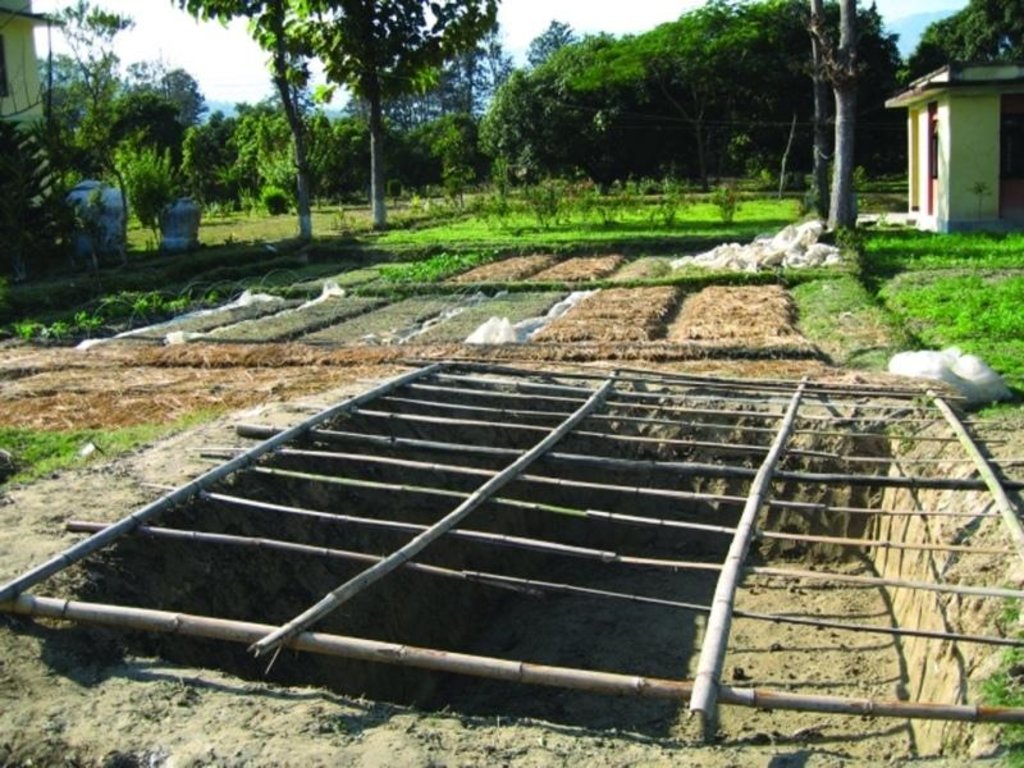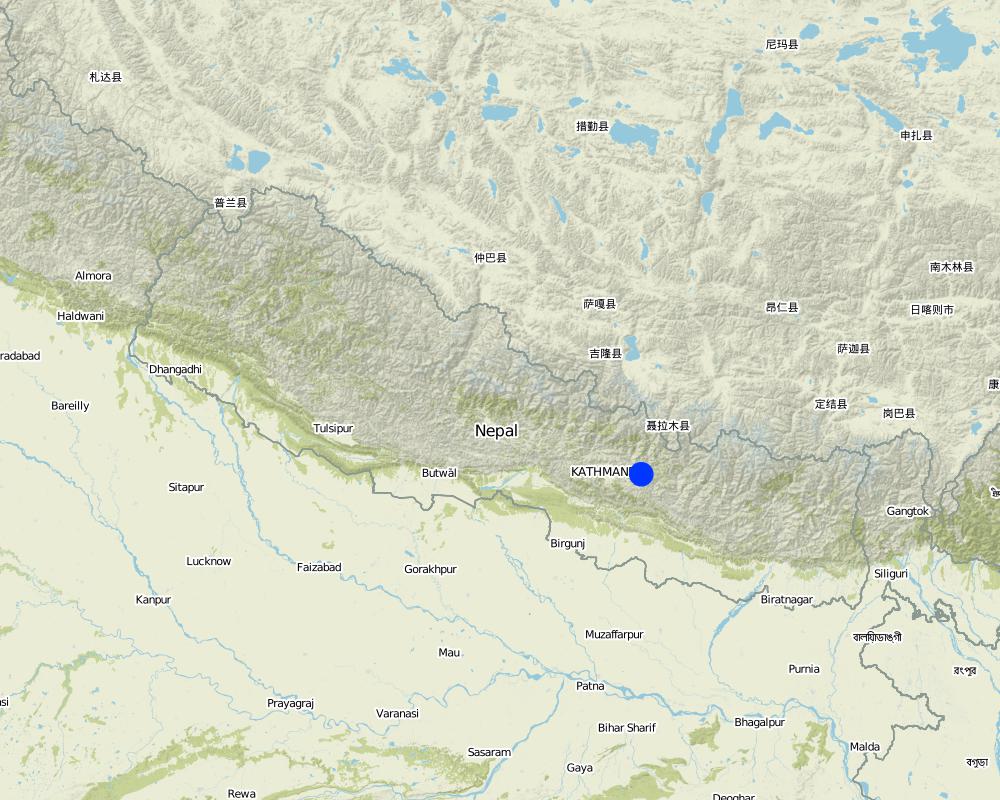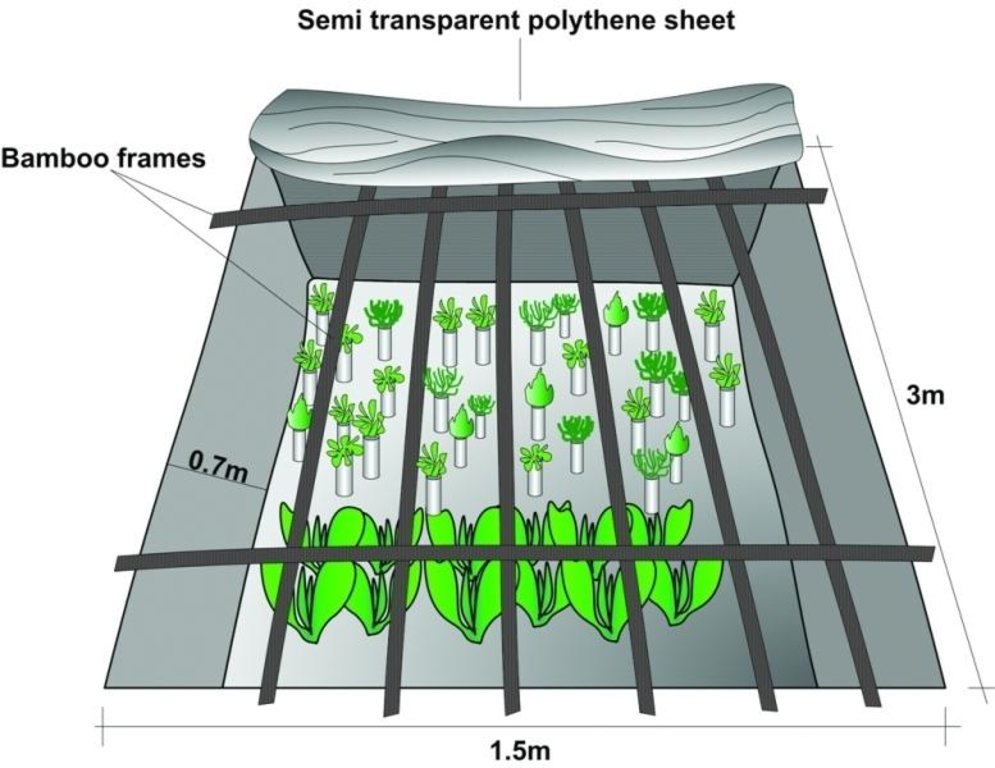Polypit nursery [ប្រទេសនេប៉ាល់]
- ការបង្កើត៖
- បច្ចុប្បន្នភាព
- អ្នកចងក្រង៖ Madhav Dhakal
- អ្នកកែសម្រួល៖ –
- អ្នកត្រួតពិនិត្យច្រើនទៀត៖ David Streiff, Alexandra Gavilano
Plastic-Khalte nursery - Nepali
technologies_1498 - ប្រទេសនេប៉ាល់
ពិនិត្យមើលគ្រប់ផ្នែក
ពង្រីកមើលទាំងអស់ បង្រួមទាំងអស់1. ព័ត៌មានទូទៅ
1.2 ព័ត៌មានលម្អិតពីបុគ្គលសំខាន់ៗ និងស្ថាប័នដែលចូលរួមក្នុងការវាយតម្លៃ និងចងក្រងឯកសារនៃបច្ចេកទេស
អ្នកជំនាញឯកទេស SLM:
អ្នកជំនាញឯកទេស SLM:
ឈ្មោះអង្គភាពមួយ (ច្រើន) ដែលបានចងក្រងឯកសារ/ វាយតម្លៃបច្ចេកទេស (បើទាក់ទង)
ICIMOD International Centre for Integrated Mountain Development (ICIMOD) - ប្រទេសនេប៉ាល់1.3 លក្ខខណ្ឌទាក់ទងទៅនឹងការប្រើប្រាស់ទិន្នន័យដែលបានចងក្រងតាមរយៈ វ៉ូខេត
អ្នកចងក្រង និង(បុគ្គលសំខាន់ៗ)យល់ព្រមទទួលយកនូវលក្ខខណ្ឌនានាទាក់ទងទៅនឹងការប្រើប្រាស់ទិន្នន័យដែលបានចងក្រងតាមរយៈវ៉ូខេត:
បាទ/ចា៎
2. ការពណ៌នាពីបច្ចេកទេស SLM
2.1 ការពណ៌នាដោយសង្ខេបពីបច្ចេកទេស
និយមន័យបច្ចេកទេស:
A simple, inexpensive and practical method for raising healthy plant seedlings
2.2 ការពណ៌នាលម្អិតពីបច្ចេកទេស
ការពណ៌នា:
During the winter in Nepal’s middle mountains, the soil temperature generally remains at 5-10 degree celsius above the ambient air temperature. This principle was used to design a simple, inexpensive, and effective nursery technology for raising vegetable and horticulture seedlings in colder regions. The polypit technology allows seedlings to be raised by protecting them from the freezing temperatures that occur mostly at night.
Polypits are about 1m deep pits dug into the ground and covered with semitransparent polythene sheets, preferably UV stabilised and supported on bamboo frames. A 30 cm high mud wall is built across the slope on the upper side of the pit. The polythene sheet is sealed on the upper side of the pit, leaving three sides unsealed but held down with stones that can be lifted to access the pit. The base and sides of the polypit are left as they are with no form of plastering.
The polythene sheet covering the pit reduces the photosynthetic photon flux (PPF) by around 30% inside the pit, still allowing sufficient sunlight to reach the plants inside. The polythene is usually removed during the day from 11 am to 4 pm to allow full sunlight to reach the plants except on rainy and very cold days. A modified version of these polypits - only 70 cm deep - were used in the Jhikhu Khola watershed to grow vegetable seedlings during the winter. The pits can be made of any reasonable size depending on the number of seedlings to be grown and the layout of the land. The Jhikhu Khola pits were about 3m long, 1.5m wide, and 0.7m deep.
Since the polypits are closed at night, the CO2 released by the plants and soil microbes accumulates and increases to well above levels outside the pit. In a completely sealed polypit, the CO2 concentration could reach up to 3000 ppm during the night which would be harmful for plants. Thus the polythene cover is only loosely sealed along the edges at night to regulate and maintain the concentration of CO2 at about two to four times the ambient concentration.
The warmer protected conditions and CO2 enrichment leads to extra growth and biomass gain for plants grown inside the pits during the winter. This technology is easy to maintain with the only maintenance costs being to repair damaged polythene sheets and frames.
The polypit technology is useful for mountain farmers where water scarcity and low temperatures limit the potential to raise quality seedlings. The technology is being promoted in the northwest Indian state of Uttarakhand, although only a few farmers have adopted it so far. It is a very promising technology and its use should be encouraged by hill farmers and research and development organisations engaged in raising seedlings. The technology needs more participatory action research to improve it and to encourage more farmers to adopt it spontaneously.
2.3 រូបភាពនៃបច្ចេកទេស
2.5 ប្រទេស/តំបន់/ទីតាំងកន្លែង ដែលបច្ចេកទេសត្រូវបានអនុវត្ត និងបានគ្រប់ដណ្តប់ដោយការវាយតម្លៃនេះ
ប្រទេស:
ប្រទេសនេប៉ាល់
បញ្ជាក់បន្ថែមពីលក្ខណៈនៃទីតាំង:
Kavrepalanchowk district/Jhikhu Khola watershed
បញ្ជាក់ពីការសាយភាយនៃបច្ចេកទេស:
- អនុវត្តនៅកន្លែងជាក់លាក់មួយ/ ប្រមូលផ្តុំនៅតំបន់តូចៗ
មតិយោបល់:
The technology was tested in the farmers field at Lamdihi and Spice Crop Development Centre. atTamaghat.
Map
×2.6 កាលបរិច្ឆេទនៃការអនុវត្ត
ប្រសិនបើមិនច្បាស់ឆ្នាំ សូមបញ្ជាក់កាលបរិច្ឆេទដែលប្រហាក់ប្រហែល:
- តិចជាង 10ឆ្នាំមុន (ថ្មី)
2.7 ការណែនាំពីបច្ចេកទេស
សូមបញ្ជាក់តើបច្ចេកទេសត្រូវបានណែនាំឱ្យអនុវត្តដោយរបៀបណា:
- ពេលកំពុងពិសោធន៍
មតិយោបល់ (ប្រភេទនៃគម្រោង ។ល។):
The technology is developed by G.B Pant Institute of Himalayan Environment and Development (GBPIHED) in Almora (India) for raising healthy plant saplings, named as polypit (Palni et al. 1994).
3. ចំណាត់ថ្នាក់នៃបច្ចេកទេស SLM
3.1 គោលបំណងចម្បង (១ ឬច្រើន) នៃបច្ចេកទេសនេះ
- ធ្វើឱ្យប្រសើរឡើងនូវផលិតកម្ម
3.2 ប្រភេទដីប្រើប្រាស់មួយប្រភេទ (ច្រើនប្រភេទ) ដែលបានអនុវត្តបច្ចេកទេស

ដីដាំដំណាំ
- ដំណាំប្រចាំឆ្នាំ
ដំណាំប្រចាំឆ្នាំ - បញ្ជាក់ប្រភេទដំណាំ:
- ធញ្ញជាតិ - ពោត
- ពពួកសណ្តែក - ផ្សេងៗ
- ដំណាំដែលមានគ្រាប់ចម្រាញ់ប្រេងបាន - ផ្កាឈូករ័ត្ន ផ្កា rapeseed ផ្សេងៗ
- បន្លែ - ផ្សេងៗ
- rice, wheat
ចំនួនសារដែលដាំដំណាំក្នុងមួយឆ្នាំ:
- 3
សូមបញ្ជាក់:
Longest growing period in days: 150; Longest growing period from month to month: Jun - Oct; Second longest growing period in days: 120; Second longest growing period from month to month: Nov - Feb
មតិយោបល់:
Major land use problems (compiler’s opinion): Production is limited due to insufficient water during winter and the pre-monsoon season (from Nov-May); insufficient
farm income due to small landholdings; increased inputs of chemical fertilisers
Major land use problems (land users’ perception): Irrigation shortage during pre-monsoon and monsoon months.
Type of cropping system and major crops comments: Maize -vegetables/wheat-vegetables
3.4 ការផ្គត់ផ្គង់ទឹក
ការផ្គត់ផ្គង់ទឹកនៅកន្លែងអនុវត្តបច្ចេកទេស:
- ទឹកភ្លៀង និងប្រព័ន្ធស្រោចស្រព
3.5 ក្រុម SLM ដែលបច្ចេកទេសស្ថិតនៅក្នុង
- full year planting
3.6 វិធានការ SLM ដែលបញ្ចូលនូវបច្ចេកទេស

វិធានការរចនាស័ម្ពន្ធ
- S4: កម្រិតភ្លឺ រណ្តៅ
4. បច្ចេកទេសជាក់លាក់ សកម្មភាពអនុវត្ត ធាតុចូល និងថ្លៃដើម
4.1 គំនូសបច្ចេកទេសនៃបច្ចេកទេសនេះ
លក្ខណៈពិសេសនៃបច្ចេកទេស (ទាក់ទងនឺងគំនូរបច្ចេកទេស):
Poly pit covered with semi transparent plastic sheet which is supported on a bamboo farme.
Technical knowledge required for field staff / advisors: low
Technical knowledge required for land users: low
Main technical functions: protecting seedlings from frost, reduction of water loss, carbon dioxide enrichment
Structural measure: pit
Depth of ditches/pits/dams (m): 0.7m
Width of ditches/pits/dams (m): 1.5 m
Length of ditches/pits/dams (m): 3 m
Construction material (earth): a mud wall is made about 30 cm high from the ground, sloping on the two sides.
Construction material (wood): to place semi transparent plastic on a frame.
Construction material (other): plastic sheet: to cover the pit, rope, wire: frame preparation
ឈ្មោះអ្នកនិពន្ធ:
Madhav Dhakal, A.K. Thaku
4.2 ព័ត៌មានទូទៅដែលពាក់ព័ន្ធនឹងការគណនាធាតុចូល និងថ្លៃដើម
កំណត់របៀបនៃការគណនាថ្លៃដើម និងធាតុចូល:
- ក្នុងឯកតាបច្ចេកទេស
បញ្ជាក់ឯកតា:
Polypit nursery
កំណត់រូបិយប័ណ្ណសម្រាប់ថ្លៃដើម:
- ដុល្លារ
កំណត់ថ្លៃឈ្នួលជាមធ្យមនៃការជួលកម្លាំងពលកម្មក្នុងមួយថ្ងៃ:
2.10
4.3 សកម្មភាពបង្កើត
| សកម្មភាព | រយៈពេល (រដូវកាល) | |
|---|---|---|
| 1. | Determine the appropriate size (length, width and depth) of the pit | beginning of the winter season |
| 2. | Mark the area for soil excavation | beginning of the winter season |
| 3. | Excavate soil from the marked area | beginning of the winter season |
| 4. | Make a mud wall (~30 cm high) from the ground, sloping on two sides | beginning of the winter season |
| 5. | Make a bamboo fram of an appropriate size | beginning of the winter season |
| 6. | Lay the frame over the pit with one end resting on the mud wall | beginning of the winter season |
| 7. | Lay the plastic sheet over the frame | beginning of the winter season |
| 8. | Seal the polythene sheet on the higher side of the mud wall and leave three sides unsealed | beginning of the winter season |
| 9. | Lay the other three sides of the polythene sheet normally at ground level and weigh down with stones that can be removed to access the pit | beginning of the winter season |
| 10. | The base and sidesof the polypit do not need any form of plastering (even with mud) | beginning of the winter season |
4.4 ថ្លៃដើម និងធាតុចូលដែលត្រូវការសម្រាប់ការបង្កើតបច្ចេកទេស
| បញ្ជាក់ពីធាតុចូល | ឯកតា | បរិមាណ | ថ្លៃដើមក្នុងមួយឯកតា | ថ្លៃធាតុចូលសរុប | % នៃថ្លៃដើមដែលចំណាយដោយអ្នកប្រើប្រាស់ដី | |
|---|---|---|---|---|---|---|
| កម្លាំងពលកម្ម | Construction of polypit nursery | Persons/unit | 1,0 | 2,1 | 2,1 | 100,0 |
| សម្ភារៈសាងសង់ | Plastic | unit | 1,0 | 4,0 | 4,0 | |
| សម្ភារៈសាងសង់ | Bamboo | unit | 1,0 | 1,3 | 1,3 | 100,0 |
| សម្ភារៈសាងសង់ | Rope | unit | 1,0 | 0,2 | 0,2 | 100,0 |
| ថ្លៃដើមសរុបក្នុងការបង្កើតបច្ចេកទេស | 7,6 | |||||
| ថ្លៃដើមសរុបក្នុងការបង្កើតបច្ចេកទេសគិតជាដុល្លារ | 7,6 | |||||
មតិយោបល់:
Duration of establishment phase: 4 month(s)
4.5 សកម្មភាពថែទាំ
| សកម្មភាព | ពេលវេលា/ ភាពញឹកញាប់ | |
|---|---|---|
| 1. | The polythene cover is opened to acclimatized the plants to the outside environment | 11:00- 16:00/Every day |
| 2. | Cleaning the pit | After trasplanting the seedlings/ once or twice in |
| 3. | Replacing the frame and polythene sheet if it gets damaged. | before raising nursery/In case of damage |
4.6 កំណត់ថ្លៃដើមសម្រាប់ការថែទាំ/ សកម្មភាពរបស់បច្ចេកទេស (ក្នុងរយៈពេលមួយឆ្នាំ)
| បញ្ជាក់ពីធាតុចូល | ឯកតា | បរិមាណ | ថ្លៃដើមក្នុងមួយឯកតា | ថ្លៃធាតុចូលសរុប | % នៃថ្លៃដើមដែលចំណាយដោយអ្នកប្រើប្រាស់ដី | |
|---|---|---|---|---|---|---|
| កម្លាំងពលកម្ម | Maintaining the pit | Persons/unit | 1,0 | 2,1 | 2,1 | 100,0 |
| ថ្លៃដើមសរុបសម្រាប់ការថែទាំដំណាំតាមបច្ចេកទេស | 2,1 | |||||
| ថ្លៃដើមសរុបសម្រាប់ការថែទាំដំណាំតាមបច្ចេកទេសគិតជាដុល្លារ | 2,1 | |||||
មតិយោបល់:
Machinery/ tools: wooden/iron peg, spade, shovel ,knife, and saw
The cost was calculated only for unit technology , and it can not be extrapolated on hectare basis as in 2006.
4.7 កត្តាសំខាន់បំផុតដែលមានឥទ្ធិពលដល់ការចំណាយ
ពណ៌នាពីកត្តាប៉ះពាល់ចម្បងៗទៅលើថ្លៃដើម:
The plastic sheet , but it is easily affordable by the land users.
5. លក្ខណៈបរិស្ថានធម្មជាតិ និងមនុស្ស
5.1 អាកាសធាតុ
បរិមាណទឹកភ្លៀងប្រចាំឆ្នាំ
- < 250 មម
- 251-500 មម
- 501-750 មម
- 751-1,000 មម
- 1,001-1,500 មម
- 1,501-2,000 មម
- 2,001-3,000 មម
- 3,001-4,000 មម
- > 4,000 មម
កំណត់បរិមាណទឹកភ្លៀង (បើដឹង) ជា មីលីម៉ែត្រ:
1200,00
តំបន់កសិអាកាសធាតុ
- សើម
Thermal climate class: subtropics
5.2 សណ្ឋានដី
ជម្រាលជាមធ្យម:
- រាបស្មើ (0-2%)
- ជម្រាលតិចតួច (3-5%)
- មធ្យម (6-10%)
- ជម្រាលខ្ពស់បន្តិច (11-15%)
- ទីទួល (16-30%)
- ទីទួលចោត (31-60%)
- ទីទួលចោតខ្លាំង (>60%)
ទម្រង់ដី:
- ខ្ពង់រាប
- កំពូលភ្នំ
- ជម្រាលភ្នំ
- ជម្រាលទួល
- ជម្រាលជើងភ្នំ
- បាតជ្រលងភ្នំ
តំបន់តាមរយៈកម្ពស់ :
- 0-100 ម
- 101-500 ម
- 501-1,000 ម
- 1,001-1,500 ម
- 1,501-2,000 ម
- 2,001-2,500 ម
- 2,501-3,000 ម
- 3,001-4,000 ម
- > 4,000 ម
មតិយោបល់ និងបញ្ចាក់បន្ថែមអំពីសណ្ឋានដី :
Altitudinal zone: 850 m a.s.l.
5.3 ដី
ជម្រៅដីជាមធ្យម:
- រាក់ខ្លាំង (0-20 សម)
- រាក់ (21-50 សម)
- មធ្យម (51-80 សម)
- ជ្រៅ (81-120 សម)
- ជ្រៅខ្លាំង (> 120 សម)
វាយនភាពដី (ស្រទាប់លើ):
- មធ្យម (ល្បាយ, ល្បាប់)
- ម៉ត់/ ធ្ងន់ (ឥដ្ឋ)
សារធាតុសរីរាង្គនៅស្រទាប់ដីខាងលើ:
- មធ្យម (1-3%)
បើអាចសូមភ្ជាប់ការពណ៌នាពីដីឱ្យបានច្បាស់ ឬព័ត៌មានដែលអាចទទួលបាន ឧ. ប្រភេទដី, pH ដី/ ជាតិអាស៊ីត, សមត្ថភាពផ្លាស់ប្តូរកាចុង, វត្តមាននីត្រូសែន, ភាពប្រៃ ។ល។:
Soil depth on average: Variable
Soil texture: Fine/ heavy (clay) is red soil with high clay content but medium (loamy, silty) is non red soil
Soil fertility is medium
Soil drainage / infiltration is medium
Soil water storage capacity is medium
5.4 ទឹកដែលអាចទាញមកប្រើប្រាស់បាន និងគុណភាពទឹក
ទឹកលើដីដែលអាចទាញយកប្រើប្រាស់បាន:
មិនមាន/ គ្មាន
គុណភាពទឹក (មិនបានធ្វើប្រត្តិកម្ម):
ទឹកពិសារដែលគ្មានគុណភាព (តម្រូវឱ្យមានការសំអាត)
មតិយោបល់ និងលក្ខណៈពិសេសផ្សេងៗទៀតលើគុណភាព និងបរិមាណទឹក :
Water quality (untreated): Also good, but more in rainy season (June- September), less in April/May; source: natural spring.
5.6 លក្ខណៈនៃអ្នកប្រើប្រាស់ដីដែលអនុវត្តបច្ចេកទេស
ទីផ្សារនៃប្រព័ន្ធផលិតកម្ម:
- ពាក់កណ្តាលពាណិជ្ជកម្ម (ផ្គត់ផ្គង់ខ្លួនឯង/ ពាណិជ្ជកម្ម)
ចំណូលក្រៅកសិកម្ម:
- 10-50% នៃចំណូល
កម្រិតជីវភាព:
- មធ្យម
ឯកជន ឬក្រុម:
- ធ្វើខ្លួនឯង/ គ្រួសារ
កម្រិតប្រើប្រាស់គ្រឿងយន្ត:
- ប្រើកម្លាំងពលកម្ម
- ប្រើកម្លាំងសត្វ
យេនឌ័រ:
- បុរស
សូមបញ្ជាក់ពីលក្ខណៈពាក់ព័ន្ធផ្សេងទៀតអំពីអ្នកប្រើប្រាស់ដី:
Land users applying the Technology are mainly common / average land users
Population density: 200-500 persons/km2
Annual population growth: 2% - 3%
100% of the land users are average wealthy and own 40% of the land.
Off-farm income specification: In most farm households off-farm income plays at least a minor and
increasingly a major role. Occasional opportunities for off-farm income present themselves in the form of daily
labour wages. Some households’ members receive regular salaries whilst an increasing number of Nepalis are
working in India, the Middle East, Malaysia and elsewhere and sending remittance incomes home.
Market orientation of production system: About 50 percent of the product , especially vegetables are grown commercially.
Level of mechanization: Manual labour for planting, irrigation, harvesting; Animals are used for field preparation and in valley bottom machines can be used for field preparation
5.7 ទំហំផ្ទៃដីជាមធ្យមនៃដីប្រើប្រាស់ដោយអ្នកប្រើប្រាស់ដី ក្នុងការអនុវត្តបច្ចេកទេស
- < 0.5 ហិកតា
- 0.5-1 ហិកតា
- 1-2 ហិកតា
- 2-5 ហិកតា
- 5-15 ហិកតា
- 15-50 ហិកតា
- 50-100 ហិកតា
- 100-500 ហិកតា
- 500-1,000 ហិកតា
- 1,000-10,000 ហិកតា
- > 10,000 ហិកតា
តើផ្ទៃដីនេះចាត់ទុកជាទំហំកម្រិតណាដែរ ខ្នាតតូច មធ្យម ឬខ្នាតធំ (ធៀបនឹងបរិបទតំបន់)?
- ខ្នាតមធ្យម
5.8 ភាពជាម្ចាស់ដី កម្មសិទ្ធប្រើប្រាស់ដី និងកម្មសិទ្ធប្រើប្រាស់ទឹក
ភាពជាម្ចាស់ដី:
- ឯកជន មានកម្មសិទ្ធ
កម្មសិទ្ធិប្រើប្រាស់ដី:
- ឯកជន
កម្មសិទ្ធប្រើប្រាស់ទឹក:
- ជាក្រុម (មានដែនកំណត់)
6. ផលប៉ះពាល់ និងការសន្និដ្ឋាន
6.1 ផលប៉ះពាល់ក្នុងបរិវេណអនុវត្តបច្ចេកទេសដែលកើតមាន
ផលប៉ះពាល់លើសេដ្ឋកិច្ចសង្គម
ផលិតផល
ការគ្រប់គ្រងដី
មតិយោបល់/ ការបញ្ជាក់:
the pit interrupted land preparation
ចំណូល និងថ្លៃដើម
ចំណូលក្នុងកសិដ្ឋាន
ផលប៉ះពាល់ទៅលើវប្បធម៌សង្គម
ចំណេះដឹង SLM / ការធ្លាក់ចុះគុណភាពដី
មតិយោបល់/ ការបញ្ជាក់:
About the polypit and their advantages
ផលប៉ះពាល់ទៅលើអេកូឡូស៊ី
ដី
សំណើមដី
មតិយោបល់/ ការបញ្ជាក់:
Inside the polypit high relative humidity is maintained.
ផលប៉ះពាល់ទៅលើអេកូឡូស៊ីផ្សេងៗ
Protection of seedlings against frost
Quality of seedlings
មតិយោបល់/ ការបញ្ជាក់:
customers prefer to buy seedlings grown in polypits compared to those grown outside
6.3 ភាពប្រឈម និងភាពរួសនៃបច្ចេកទេសទៅនឹងការប្រែប្រួលអាកាសធាតុ និងគ្រោះអាកាសធាតុ/ គ្រោះមហន្តរាយ (ដែលដឹងដោយអ្នកប្រើប្រាស់ដី)
ការប្រែប្រួលអាកាសធាតុ
ការប្រែប្រួលអាកាសធាតុ
| រដូវកាល | កើនឡើង ឬថយចុះ | លក្ខណៈឆ្លើយតបនៃបច្ចេកទេសទៅនឹងការប្រែប្រួលអាកាសធាតុ | |
|---|---|---|---|
| សីតុណ្ហភាពប្រចាំឆ្នាំ | កើនឡើង | ល្អ |
គ្រោះអាកាសធាតុ (មហន្តរាយ)
គ្រោះមហន្តរាយធម្មជាតិ
| លក្ខណៈឆ្លើយតបនៃបច្ចេកទេសទៅនឹងការប្រែប្រួលអាកាសធាតុ | |
|---|---|
| ព្យុះភ្លៀងតាមតំបន់ | ល្អ |
| ព្យុះកំបុតត្បូងតាមតំបន់ | ល្អ |
គ្រោះមហន្តរាយអាកាសធាតុ
| លក្ខណៈឆ្លើយតបនៃបច្ចេកទេសទៅនឹងការប្រែប្រួលអាកាសធាតុ | |
|---|---|
| រាំងស្ងួត | ល្អ |
គ្រោះមហន្តរាយទឹក
| លក្ខណៈឆ្លើយតបនៃបច្ចេកទេសទៅនឹងការប្រែប្រួលអាកាសធាតុ | |
|---|---|
| ទឹកជំនន់ទូទៅ (ទន្លេ) | ល្អ |
ផលវិបាកដែលទាក់ទងនឹងបរិយាកាសផ្សេងៗទៀត
ផលវិបាកដែលទាក់ទងនឹងបរិយាកាសផ្សេងៗទៀត
| លក្ខណៈឆ្លើយតបនៃបច្ចេកទេសទៅនឹងការប្រែប្រួលអាកាសធាតុ | |
|---|---|
| កាត់បន្ថយពេលដាំដុះ | មិនស្គាល់ |
6.4 ការវិភាគថ្លៃដើម និងអត្ថប្រយោជន៍
តើផលចំណេញ និងថ្លៃដើមត្រូវបានប្រៀបធៀបគ្នាយ៉ាងដូចម្តេច (ទស្សនៈរបស់អ្នកប្រើប្រាស់ដី)?
រយៈពេលខ្លី:
វិជ្ជមាន
រយៈពេលវែង:
វិជ្ជមានខ្លាំង
តើផលចំណេញ និងការថែទាំ/ ជួសជុលត្រូវបានប្រៀបធៀបគ្នាយ៉ាងដូចម្តេច (ទស្សនៈរបស់អ្នកប្រើប្រាស់ដី)?
រយៈពេលខ្លី:
វិជ្ជមានខ្លាំង
រយៈពេលវែង:
វិជ្ជមានខ្លាំង
មតិយោបល់:
The investment costs can be recouped within one season leading to positive results due to higher production.
6.5 ការទទួលយកបច្ចេកទេស
- តែមួយករណី /ពិសោធន៍
បើអាច សូមបញ្ជាក់ពីបរិមាណ (ចំនួនគ្រួសារ និង/ ឬតំបន់គ្របដណ្តប់):
2 households
ក្នុងចំណោមគ្រួសារទាំងអស់ដែលបានអនុវត្តបច្ចេកទេស តើមានប៉ុន្មានគ្រួសារដែលចង់ធ្វើដោយខ្លួនឯង ដោយមិនទទួលបានសម្ភារៈលើកទឹកចិត្ត/ប្រាក់ឧបត្ថម្ភ?:
- 0-10%
មតិយោបល់:
100% of land user families have adopted the Technology with external material support
2 land user families have adopted the Technology with external material support
Comments on acceptance with external material support: survey results
There is no trend towards spontaneous adoption of the Technology
Comments on adoption trend: There were not enough dissemination and awareness raising activities to inform farmers of the benefits of the technology and convince them to use it.
6.7 ភាពខ្លាំង/ គុណសម្បត្តិ/ ឱកាសនៃបច្ចេកទេស
| ភាពខ្លាំង/ គុណសម្បត្តិ/ ឱកាសនៅកន្លែងរបស់អ្នកប្រើប្រាស់ដី |
|---|
|
The survival rate for vegetable seedlings is higher and seedlings mature about two weeks earlier than if grown outside where they take about one month to be ready, leading to additional income for farmers How can they be sustained / enhanced? Every aspect of the technology should be highlighted through experience sharing programmes |
| ភាពខ្លាំង/ គុណសម្បត្តិ/ ឱកាស ទស្សនៈរបស់បុគ្គលសំខាន់ៗ |
|---|
|
Polypits are a simple, inexpensive, practical and effective technique for raising and protecting plant seedlings from severe winter temperatures.They can be called ‘poor farmers greenhouses’ How can they be sustained / enhanced? More dissemination and awareness raising activities are needed to inform more farmers about the benefits of this technology |
|
The high relative humidity in polypits means that watering only needs to be carried out once or twice a month in comparison to fi ve to six times for open nursery beds, thus saving labour and water How can they be sustained / enhanced? Every aspect of the technology should be highlighted through experience sharing programmes |
|
The more physical conditions and CO2 enrichment in the pits during the winter months are refl ected in the extra growth and biomass gain of plants grown inside the pits How can they be sustained / enhanced? As above |
6.8 ភាពខ្សោយ/ គុណវិបត្តិ/ ហានិភ័យនៃបច្ចេកទេស និងវិធីសាស្ត្រដោះស្រាយ
| ភាពខ្សោយ/ គុណវិបត្តិ/ ហានិភ័យ ទស្សនៈរបស់អ្នកប្រើប្រាស់ដី | តើបច្ចេកទេសទាំងនោះបានដោះស្រាយបញ្ហាដូចម្តេច? |
|---|---|
| In the demonstration, the bamboo frame to hold the sheet was too heavy making it diffi cult for the farmer to remove the frame and work inside. | Use a modifi ed frame with a space built in to allow a person to enter the pit easily without having to remove the frame. |
| ភាពខ្សោយ/ គុណវិបត្តិ/ ហានិភ័យ ទស្សនៈរបស់អ្នកចងក្រងឬបុគ្គលសំខាន់ៗ | តើបច្ចេកទេសទាំងនោះបានដោះស្រាយបញ្ហាដូចម្តេច? |
|---|---|
| In completely sealed polypits, the CO2 concentration can become so high during the night that it harms the plants | Only loosely seal the sheet at night to regulate and maintain the CO2 concentration |
7. ឯកសារយោង និងវេបសាយ
7.1 វិធីសាស្ត្រ/ ប្រភពនៃព័ត៌មាន
7.2 ឯកសារយោងដែលបានចេញផ្សាយ
ចំណងជើង អ្នកនិពន្ធ ឆ្នាំ ISBN:
Bhuchar, S. (2004) Polypit: a Green-chamber for Poor Farmers, an article prepared for PARDYP Quarterly e-Newsletter-8, ICIMOD, Kathmandu
មានប្រភពមកពីណា? ថ្លៃដើមប៉ុន្មាន?
ICIMOD
ចំណងជើង អ្នកនិពន្ធ ឆ្នាំ ISBN:
Palni, L.M.S.; Bhuchar, S.; Kothyari, B.P. (1994) ‘A Simple Polypit can Greatly Reduce Nursery Time of Tree Seedlings”. In Journal of HIMA-PARYAVARAN, 6(2):10-11
មានប្រភពមកពីណា? ថ្លៃដើមប៉ុន្មាន?
GBPIHED- Almora
ចំណងជើង អ្នកនិពន្ធ ឆ្នាំ ISBN:
Vyas, P.; Bisht, M.S.; Bhuchar, S.; Sharma, S.; Palni, L.M.S. (1999) ‘Polypit: An Improved Technique for Raising Nursery Plants’. In Journal of Sustainable Forestry, 8(1): 43-59
មានប្រភពមកពីណា? ថ្លៃដើមប៉ុន្មាន?
GBPIHED- Almora
ការតភ្ជាប់ និងម៉ូឌុល
ពង្រីកមើលទាំងអស់ បង្រួមទាំងអស់ការតភ្ជាប់
គ្មានការតភ្ជាប់
ម៉ូឌុល
គ្មានម៉ូឌុល





